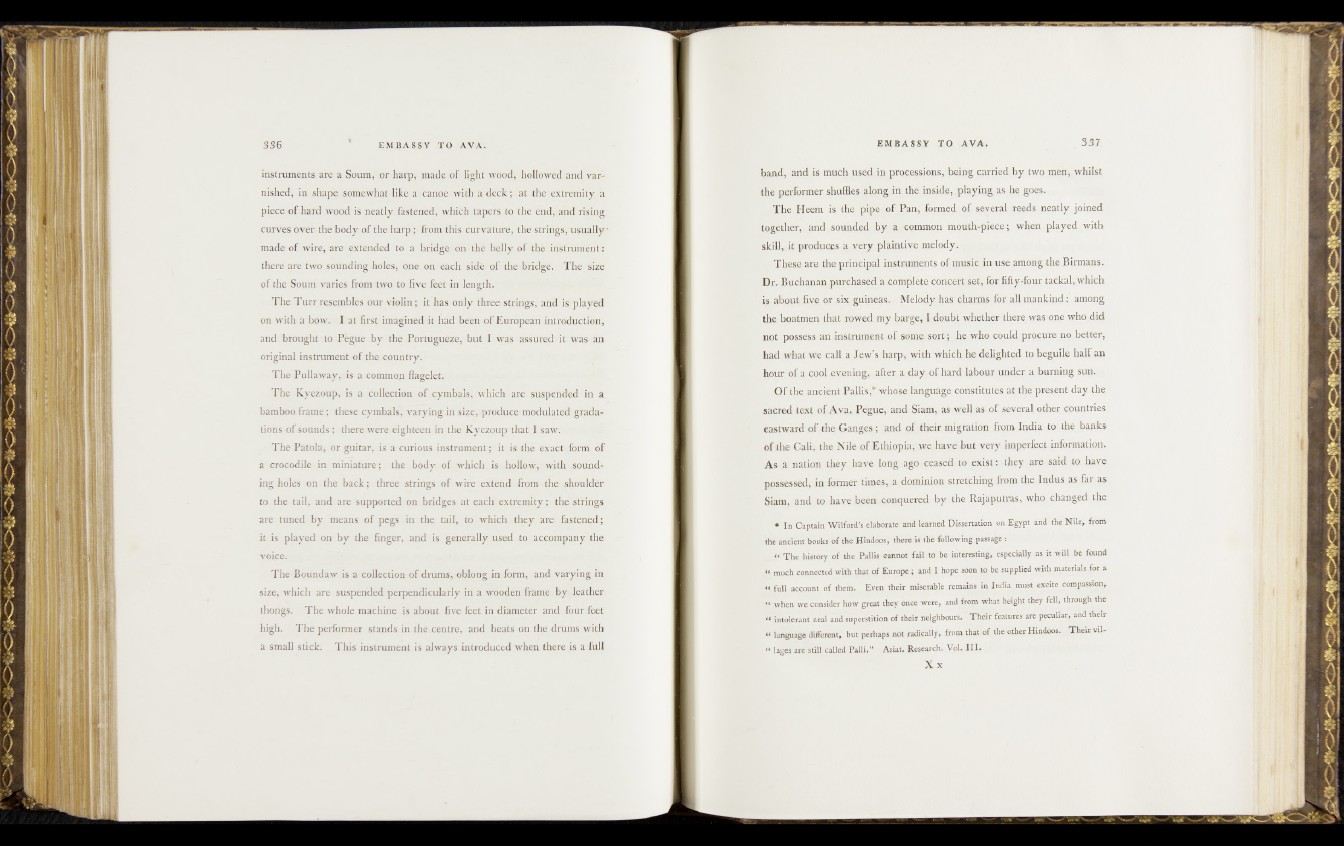
instruments are: a Soum,>x>r harp, made of light'wood,■ MollbWed-and varnished,
in shape _somewhatjjfke ascano© with aj deck ;,c atscthe -extremity. a
piece of hard wood "is greatly .fastened, which tapcis to the cnd^aricbwsihg
curves-over the .body of the-harp; from this-eurvature, the-string vfüVSia] 1-p
made'of wire, are* extended to & bridge on the •'belly of the
there are. two -sounding holes ,i>one on"'etfeh' sidSiofa-the bridge. The size
of the Soum varies .from two to .'fevp-Jfetsbn length.
The Turr resembles our violin ^ it has only three sfcririgsf'.aijd- is*> played
om with adbow. I at first imagined it had been ‘ofiEuropéanSii^rdiiS'tion;
and brought to .Pégue b y the Portugueze, but I was assured
original instrument of the country.
The Pullaway,.«is a common f la tle t.
The Kyezoup, is a collection of cymbals, which are suspended in a
bamboo frame; these cymbals, varying in size, produce modulated gradations
of sounds; there were eighteen in the Kyezoup that I saw. ^
The Patola, or guitar, is a curious instrument; it is the exact form of
a crocodile in miniature; the body of which is .-hollow, with sounding
holes on the back; three strings of wire extend from the shoulder
to the tail, and are supported on bridges at each extremity; the strings
are tuned by means of pegs in the tail, to which they are fastened;
it is played on by the finger, and is generally used to accompany the
voice. / ,
The Boundaw is a collection of drums! oblong in form, and varying in
size, which are suspended perpendicularly in a wooden frame by. leather
thongs. The whole machine is about five feet in diameter and four feet
high. The performer stands in thé centre, and beats on the drums with
a small stick. This instrument is always introduced when there is a hill
band, and is much used imnyoeps^ops,’ being parried'by two men, whilst
the performer shuffles afong,iif ithe, ip^idp, .jdaying as he goes.
The: Heém • is,'th'eipip,e of Pan, formed of geveraEreeds neatly joined
together, and sounded.by a common ; when .pjftyfd with
iSdll,, i£ produces a very plajutivemtelody^i^jii
. Thesp-.ar-e' the principal instruments, efi music in use among the Birmans.
Dr. Buchanan purchased %^§dmpletei fil|yfföur tackah which
about five or six guineas. 'j^el^sfelias charms* fotfjgli mankind-: anumg
the boatmen that rowed my jbargp* I do.uht whether jtbejse was one who d id
not possess an instrument .of semg, sp-rlj^ lw,jwbcr,ppuld procure no better,
had what 'we cafl a Jew’s'hafp, with which he delighted tp, beguile half an
hour of a mol^«BUS|g,,.lifter a. day.pfffiard labour under, a burning sun:
yL .Ofithejancient Palhs,lwh0,^dynguag e ^ n s titü te s ^ th e present day the
sacred text o fA v a , Pégue, and Siam, a sw ^ l as of several other ppuntries
eastward o f the Canges; yaÜ o f their migration from India to' the hanks
of the C a li,ih e b! Me ofEthiopia,we have but very, imperfect ^formation.
A c * nation they 'havé long agor-eeuseftoto exist :,-thpy.are .said to have
possessed, at fo ta e r times,, a dominion stretching from the Iijdus as far as
Siam, and to have fieea: conquered by the Rajaputras, who changed the
-* In Captain Wilford’s elaborate and learned Dissertation on Egypt and the N ile, from
tfee ïfindöps, there is the following passage:
« The Ajstwy of foe M b s eanns>t fab, to be intereffong, especially, »s it will he found
' ; 0 much connected with that of Europe ; and I hope soon to he supplied with materials for a
« fy.11. account of them. Even their miserable remains in India must excite compassion,
“ when we consider how great they once were, and from what height they fell, through^te
« intolerant zeal and superstition of their neighbours. Their features are peculiar, and their
« lanpiag». different, but perhaps not radically, from that of the other Hindoos. Their vü-
« lages are still called Palli." Asiat. Research, Vob-JII.
X x